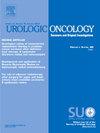DRIVER MUTATIONS ASSOCIATED WITH SIGNATURES OF PLATINUM SENSITIVITY IN GERM CELL TUMORS
IF 2.4
3区 医学
Q3 ONCOLOGY
Urologic Oncology-seminars and Original Investigations
Pub Date : 2025-03-01
DOI:10.1016/j.urolonc.2024.12.088
引用次数: 0
Abstract
Introduction
A subset of patients with germ cell tumors (GCTs) develop platinum resistance disease resulting in inferior survival outomes. The mechanisms driving resistance are complex and not yet fully understood. We sought to evaluate the genomic and transcriptomic landscapes in primary and metastatic GCTs to uncover genetic factors that drive cisplatin resistance in GCTs.
Methods
GCTs (N = 138) were analyzed by next-generation sequencing of DNA (592-gene or whole exome) and RNA (whole transcriptome). Prevalence was calculated for pathogenic mutations and high copy number amplifications (CNA ³ 6 copies). Primary (N = 65, primary), lymph node metastasis (N=14, lymph), and non-lymph metastatic lesions (N = 59, metastasis) were defined based on the tissue site relative to known primary site. An independent genitourinary pathologist reviewed H&E-stained slides and designated tumors as chemo-naïve (PreC, N = 66) or post-chemotherapy (PostC, N = 17) based on absence or presence of morphologic evidence of treatment related changes. Platinum Resistant Alterations (PRAs, defined from prior literature) included KRAS, TP53, and KIT mutations, and MDM2 amplification. A transcriptomic signature associated with platinum sensitivity (Platinum sensitivity score: PSS, high score suggests increased platinum sensitivity) was applied. Mann-Whitney U and tests were applied as appropriate, with P-values adjusted for multiple comparisons.
Results
Sixty-five primary tumors were sequenced, including 7 intracranial primary tumors, 5 mediastinal primary tumors, 16 ovarian primary tumors, and 37 testicular primary tumors. Seventy-three samples were obtained from metastatic sites (including lymph nodes) based on clinician annotation. This included two from bone, 11 from the brain, six from the liver, five from the lung, 14 from lymph nodes, four from the mediastinum, 12 from the peritoneum, one from the spermatic cord, and 18 from non-bone/liver/brain visceral sites (ie. kidney, small intestine, connective tissue, etc). Compared to non-lymph node and lymph node metastases, patients with biopsy from primary tumors had a significantly lower median age at the time of biopsy (24 vs 34 and 41 years, respectively, p < 0.001), were more frequently female (29.2% vs 13.6% and 7.1%, respectively, p < 0.42), and were more frequently chemo-naïve (92.1% vs 73.5% and 54.5%, respectively, p < 0.01) (Table 1). The genomic variation landscape of GCTs was sparse, and predominantly made up of recurrent genetic variants previously associated with driver mutation or chemotherapy resistance (KIT-Mt, KRAS-Mt, TP53-Mt, PTEN-Mt, KRAS-Amp and MDM2-Amp). As a result, our investigation focused on these genes (Fig 2). KIT mutations were observed in 14.5% of primary versus 1.8% of met and 0% of lymph cases. TP53 mutations were identified in 10% of primary GCTs versus 17% of met and 16.7% of lymph cases. MDM2 CNAs were similar between primary, met and lymph cohorts (3.7% vs 1.9% vs 8.3%) (all p > 0.05). PRA positive PreC GCTs had a significantly lower average PSS score compared to PRA negative tumors (-5.44 vs 2.17 arbitrary units, p = 0.02). KRAS-Amp alterations were often concurrent with another PRA and were generally associated with a positive PSS, which may suggest a potential link between MAPK signaling and platinum sensitivity. Although rare, both MDM2-Amp tumors had very low PSS.
Conclusions
The prevalence of PRAs does not significantly vary by site. Lower PSS scores in chemo-naïve tumors were associated with PRAs, suggesting a potential mechanism for platinum-based chemotherapy resistance.
与生殖细胞肿瘤铂敏感性特征相关的驱动突变
生殖细胞肿瘤(gct)患者的一部分发展为铂耐药疾病,导致较差的生存结果。驱动耐药性的机制很复杂,尚未完全了解。我们试图评估原发性和转移性gct的基因组和转录组学景观,以揭示驱动gct顺铂耐药的遗传因素。方法对sgct (N = 138)进行DNA(592基因或全外显子组)和RNA(全转录组)的新一代测序。计算致病性突变和高拷贝数扩增(CNA³6拷贝)的患病率。原发性(N = 65,原发),淋巴结转移(N=14,淋巴结转移)和非淋巴结转移病变(N = 59,转移)的定义基于相对于已知原发部位的组织部位。独立的泌尿生殖系统病理学家检查了H&; e染色玻片,根据有无治疗相关改变的形态学证据,将肿瘤指定为chemo-naïve (PreC, N = 66)或化疗后(PostC, N = 17)。铂抗性改变(PRAs,根据先前文献定义)包括KRAS、TP53和KIT突变以及MDM2扩增。应用与铂敏感性相关的转录组特征(铂敏感性评分:PSS,高评分表明铂敏感性增加)。酌情采用Mann-Whitney U和检验,并根据多重比较调整p值。结果共对65例原发肿瘤进行测序,其中颅内原发肿瘤7例,纵隔原发肿瘤5例,卵巢原发肿瘤16例,睾丸原发肿瘤37例。根据临床医生的注释,从转移部位(包括淋巴结)获得73份样本。这包括2个来自骨骼,11个来自大脑,6个来自肝脏,5个来自肺部,14个来自淋巴结,4个来自纵隔,12个来自腹膜,1个来自精索,18个来自非骨骼/肝脏/大脑内脏部位(即肺)。肾、小肠、结缔组织等)。与非淋巴结和淋巴结转移相比,原发肿瘤活检患者在活检时的中位年龄明显较低(分别为24岁对34岁和41岁,p <;0.001),女性更常见(分别为29.2%比13.6%和7.1%,p <;0.42),并且频率更高chemo-naïve(分别为92.1% vs 73.5%和54.5%),p <;0.01)(表1)。gct的基因组变异景观稀疏,主要由先前与驱动突变或化疗耐药相关的复发性遗传变异(KIT-Mt, KRAS-Mt, TP53-Mt, PTEN-Mt, KRAS-Amp和MDM2-Amp)组成。因此,我们的研究集中在这些基因上(图2)。在14.5%的原发性病例中观察到KIT突变,而在1.8%的met病例和0%的淋巴病例中观察到KIT突变。在10%的原发性gct中发现了TP53突变,而在met病例中为17%,在淋巴病例中为16.7%。原发性、met组和淋巴组的MDM2 CNAs相似(3.7% vs 1.9% vs 8.3%)(所有p >;0.05)。与PRA阴性肿瘤相比,PRA阳性PreC gct的平均PSS评分显著降低(-5.44 vs 2.17任意单位,p = 0.02)。KRAS-Amp的改变通常与另一种PRA同时发生,并且通常与PSS阳性相关,这可能表明MAPK信号传导与铂敏感性之间存在潜在联系。虽然罕见,但两种MDM2-Amp肿瘤的PSS都很低。结论不同部位的pra患病率差异不显著。chemo-naïve肿瘤的PSS评分较低与PRAs相关,提示铂基化疗耐药的潜在机制。
本文章由计算机程序翻译,如有差异,请以英文原文为准。
求助全文
约1分钟内获得全文
求助全文
来源期刊
CiteScore
4.80
自引率
3.70%
发文量
297
审稿时长
7.6 weeks
期刊介绍:
Urologic Oncology: Seminars and Original Investigations is the official journal of the Society of Urologic Oncology. The journal publishes practical, timely, and relevant clinical and basic science research articles which address any aspect of urologic oncology. Each issue comprises original research, news and topics, survey articles providing short commentaries on other important articles in the urologic oncology literature, and reviews including an in-depth Seminar examining a specific clinical dilemma. The journal periodically publishes supplement issues devoted to areas of current interest to the urologic oncology community. Articles published are of interest to researchers and the clinicians involved in the practice of urologic oncology including urologists, oncologists, and radiologists.

 求助内容:
求助内容: 应助结果提醒方式:
应助结果提醒方式:


